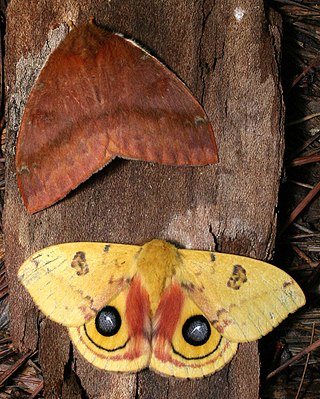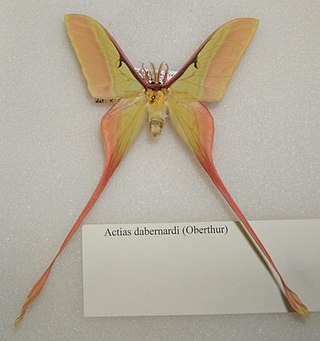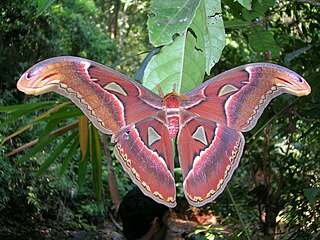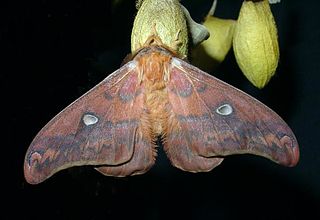
The luna moth, also called the American moon moth, is a Nearctic moth in the family Saturniidae, subfamily Saturniinae, a group commonly named the giant silk moths.

Eacles imperialis, the imperial moth, is a member of the family Saturniidae and subfamily Ceratocampinae. It is found mainly in the East of South America and North America, from the center of Argentina to south Canada. The species was first described by Dru Drury in 1773.

Antheraea polyphemus, the Polyphemus moth, is a North American member of the family Saturniidae, the giant silk moths. It is a tan-colored moth, with an average wingspan of 15 cm (6 in). The most notable feature of the moth is its large, purplish eyespots on its two hindwings. The eyespots give it its name – from the Greek myth of the cyclops Polyphemus. The species was first described by Pieter Cramer in 1776. The species is widespread in continental North America, with local populations found throughout subarctic Canada and the United States. The caterpillar can eat 86,000 times its weight at emergence in a little less than two months. Polyphemus moths are considered to be very polyphagous, meaning they eat from a wide variety of plants.

Hyalophora cecropia, the cecropia moth, is North America's largest native moth. It is a member of the family Saturniidae, or giant silk moths. Females have been documented with a wingspan of five to seven inches or more. These moths can be found all across North America as far west as Washington and north into the majority of Canadian provinces. Cecropia moth larvae are most commonly found on maple trees, but they have also been found on cherry and birch trees among many others. The species was first described by Carl Linnaeus in his 1758 10th edition of Systema Naturae.

Dryocampa rubicunda, the rosy maple moth, is a small North American moth in the family Saturniidae, also known as the great silk moths. It was first described by Johan Christian Fabricius in 1793. The species is known for its wooly body and pink and yellow coloration, which varies from cream or white to bright pink or yellow. Males have bushier antennae than females, which allow them to sense female pheromones for mating.

Actias selene, the Indian moon moth or Indian luna moth, is a species of saturniid moth from Asia. It was first described by Jacob Hübner in 1807. This species is popular among amateur entomologists and is often reared from eggs or cocoons that are available from commercial sources. They fly mainly at night.

Citheronia regalis, the regal moth or royal walnut moth, is a North American moth in the family Saturniidae. The caterpillars are called hickory horned devils. The adult (imago) has a wingspan of 3.75–6.1 in (9.5–15.5 cm). The species was first described by Johan Christian Fabricius in 1793.

Automeris io, the Io moth or peacock moth, is a colorful North American moth in the family Saturniidae. The Io moth is also a member of the subfamily Hemileucinae. The name Io comes from Greek mythology in which Io was a mortal lover of Zeus. The Io moth ranges from the southeast corner of Manitoba and in the southern extremes of Ontario, Quebec, New Brunswick and Nova Scotia in Canada, and in the US it is found from Montana, North Dakota, South Dakota, Nebraska, Colorado, New Mexico, Texas, Utah, east of those states and down to the southern end of Florida. The species was first described by Johan Christian Fabricius in 1775.

The saddleback caterpillar is the larva of a species of moth native to eastern North America. It is also found in Mexico. The species belongs to the family of slug caterpillars, Limacodidae.

Actias is a genus of Saturniid moths, which contains the Asian-American moon moths. Long tails on their hindwings are among their distinctive traits. Other moths with similar appearance are Copiopteryx, Argema and Eudaemonia.

Graellsia isabellae, the Spanish moon moth, is in the silkmoth family Saturniidae. It is the only species in the monotypic genus Graellsia. The species was first described by Mariano de la Paz Graells y de la Agüera in 1849 and the genus was erected by Augustus Radcliffe Grote in 1896.

Actias dubernardi, the Chinese moon moth, is a moth of the family Saturniidae. The species was first described by Charles Oberthür in 1897.

Actias isis is a moth of the family Saturniidae first described by Léon Sonthonnax in 1899.

Actias ningpoana, the Chinese moon moth, is a moth of the family Saturniidae. The species was first described by father-and-son entomologists Cajetan and Rudolf Felder in 1862. It is quite large, and has long, curved, hindwing tails. There are many congeners across Asia; the Luna moth of Eastern Canada and the United States is a close relative.

Attacus is a genus of moths in the family Saturniidae. The genus was named by Carl Linnaeus in his 1767 12th edition of Systema Naturae.

Antheraea paphia, known as the South India small tussore, the tasar silkworm and vanya silkworm is a species of moth of the family Saturniidae found in India and Sri Lanka. The bulk of the literature on this species uses a junior synonym, Antheraea mylitta, rather than the correct name, A. paphia. It is one of a number of tasar silkworms, species that produce Tussar silk, a kind of wild silk that is made from the products of saturniid silkworms instead of the domesticated silkworm.

Attacus taprobanis is a moth of family Saturniidae. It is native to southern India and Sri Lanka. This species is very similar in morphology to the much more widely distributed Attacus atlas. It was once considered a subspecies of A. atlas.

Hemileuca lucina, the New England buck moth, is a species of moth in the family Saturniidae. This moth species is only found in the New England region of the United States. Larvae in early stages mainly feed on broadleaf meadowsweet whereas larvae in later stages show variation in food sources such as blackberry and black cherry leaves. Larvae have a black body with orange/black spines on their back that are used to deter predators. Pupation occurs during the summer and adult moths come out around September.

Rhodinia fugax, the squeaking silkmoth, is a moth in the family Saturniidae. It was described by Arthur Gardiner Butler in 1877. It is native to Korea, Japan, China, and the Russian Far East.

Trabala pallida is a species of moth in the family Lasiocampidae. They can be found from Southeast China, south throughout Thailand and most of Sundaland. One subspecies is Trabala pallida montana.





















